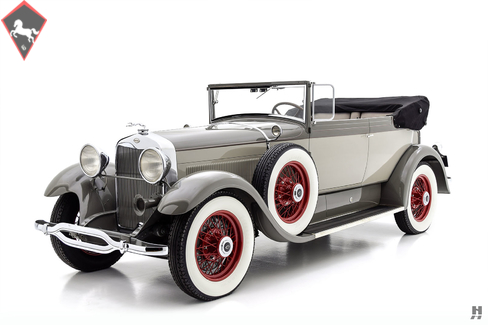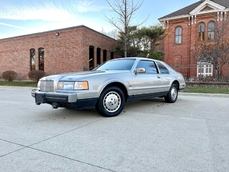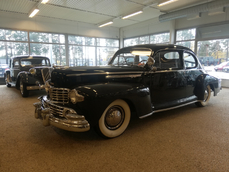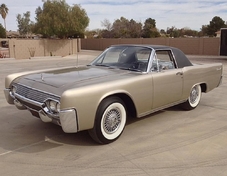Lincoln Other L Convertible Victoria 1929
Allgemeine Beschreibung :
In 1902, Henry M. Leland was charged with appraising the assets of The Henry Ford Company prior to its liquidation. Rather than liquidate the stocks, Leland suggested the firm reorganize and build a new car based on an engine he had previously designed for Olds. Henry Ford was forced out, and the new company was reorganized as Cadillac. Leland applied lessons he learned in the firearms business to automobile production, particularly in the use of interchangeable parts. Leland sold Cadillac to General Motors in 1909, but remained in charge, keeping Cadillac at the forefront of the automobile industry. A dispute with Billy Durant over the production of Liberty Aircraft engines led to Leland and his son-in-law departing from Cadillac in 1916. Leland secured a ten-million-dollar grant and soon started a new company, named for his hero, Abraham Lincoln. They built Liberty engines for the war effort; however, the Armistice came before Lincoln could fully establish itself, so the Lelands fell back on making what they knew best – luxury automobiles.
The Lincoln Model L was Henry Leland’s first production car, debuting in September 1920. The L was technically excellent, with its fork-and-blade 60-degree V8, torque tube drive, and robust chassis. Leland’s perfectionism delayed production, with the car debuting at the start of a post-war recession. The styling was also seen as dowdy and lacking the suitable Jazz-Age flamboyance that was necessary on such a pricey automobile. Initial sales were slow and financial troubles hit the company hard. Despite Leland’s vehement opposition, the board elected to sell Lincoln to Henry Ford for $8 million. Ford, perhaps acting in retribution, soon displaced Leland and assigned his son Edsel to head the new division. Edsel, unlike his father, understood the importance of style and he designed a new body for the L-series, also improving the handling by fitting hydraulic shock absorbers. Production was streamlined, saving vast amounts of money and turning Lincoln into a profitable business in less than a year, all while producing a superior product, despite Henry Leland’s fears to the contrary.
The V8 Lincoln L would continue to be a mainstay of the lineup for the remainder of the 1920s. It would, of course, see numerous improvements along the way. By 1929, it was reaching the end of its run and benefitted from the years of refinement by Ford’s engineers. The antiquated styling was a thing of the past, replaced by handsome sweeping lines designed under Edsel’s supervision. No fewer than thirty-nine different bodies were available from the factory or America’s finest coachbuilders, including Dietrich, Willoughby, LeBaron, and Brunn. The technical spec was mostly unchanged from 1928, except for some subtle mechanical refinements made to the chassis. Today, the Lincoln L is a favorite among classic-era enthusiasts for its excellent road manners, respectable power, and understated elegance.
This 1929 Lincoln L is a truly stunning example and one of just eight cars to wear this fantastic Convertible Victoria coachwork by Dietrich. A sporty and elegant car, the Lincoln was reportedly first owned by “Mr. Roberts” who an early celebrity hair stylist. By the 1950s, the Lincoln was discovered in a New York City parking garage, and by 1970, had been acquired by Ken Kenewell. Mr. Kenewell is a longtime classic era enthusiast with a particular fondness for these early Lincolns. In the 1990s, the car was treated to a meticulous restoration to beautiful concours standards and was shown at the 1999 Pebble Beach Concours d’Elegance. Also, it earned a CCCA Senior Premier award (No. 133), an AACA Grand National First prize in 1999, and is featured in Beverly Rae Kimes’ book “The Classic Era."
Since its restoration, this car has been maintained in exceptional condition. Finished in handsome two-tone warm gray accented with red Buffalo wire wheels (an option in 1929) and dark red coach stripes, this is undoubtedly one of the most attractive and fascinating open Lincoln designs of the era. The paint quality is outstanding, with impeccable quality finish work and fine detailing. Chrome plating is also excellent, remaining in incredible condition since the restoration. The body is minimally adorned, with just a Greyhound mascot, dual side-mount spares, dual cowl lamps, and a fitted trunk for a clean and crisp look.
The interior is particularly elegant, with individual armchair seats trimmed in gray Bedford cord cloth, with vibrant dark red leather piping and backing. Like the exterior, the interior is exceptionally well-preserved and presents in excellent condition. Upholstery shows minimal use, with only some very light wearing on the front seat cushions visible on close inspection. Front floors are finished in gray linoleum while the rear passenger compartment is carpeted in red. For additional luggage capacity, the rear seats cleverly fold out of the way, transforming the car into a sporty two-seater. Interior hardware and fittings are in excellent order – from the restored original instruments to the beautiful wood steering wheel and the fine nickel-plated hardware. The intriguing top configuration gives the car a “convertible coupe” look with its removable rear quarter windows, which are also hinged for ventilation. Folding the roof and stowing the side windows gives this Lincoln a decidedly sporty appeal.
Lincoln’s 60-degree V8 is one of the great engines of the era. Noted for its smoothness and precision, it produces 90 horsepower at 2,800 rpm and sends power through a 3-speed sliding gear transmission and torque-tube driveshaft. The engine presentation is outstanding, with correct clamps, hardware, and finishes on the crankcase, cylinder blocks, and heads. Some of the finish has baked-off the manifolds in places, which is not uncommon given the car has been carefully enjoyed since its restoration, but the overall presentation remains very impressive.
This handsome and exceptionally rare Lincoln represents the best that Ford Motor Company had to offer in 1929, as well as highlighting Raymond Dietrich’s exquisite craftsmanship and unique style. The fabulous restoration has been lovingly maintained, and this car remains in truly stunning condition, still suitable for concours events or for CCCA CARavan Tours. As one of just eight built, this represents a unique opportunity to acquire an impeccably restored and breathtaking Full Classic Lincoln.
https://hymanltd.com/vehicles/6284
1929 Lincoln Other L Convertible Victoria is listed verkauft on ClassicDigest in St. Louis by Mark Hyman for $159500.
Fakten der Auto
Karosserietyp : Auto Marke : Lincoln Modell : Other Ausführung : L Convertible Victoria Hubraum : 0.0 Modelljahr : 1929 Karosstyp : Convertible Lage : Missouri
Verkauft
Angaben Zum Verkäufer
Verkauft
People who viewed this Lincoln Other also viewed similar Lincoln listed at ClassicDigest
Other cars listed for sale by this dealer
über Lincoln
Lincoln, oft mehr als nur ein gehobenes Ford betrachtet, hat sich mit einer reichen Geschichte und einer Auswahl von unverwechselbaren Modellen einen eigenen Platz in der Automobilwelt geschaffen. Lassen Sie uns einen Spaziergang durch die Erinnerungen der Geschichte von Lincoln machen.Die Anfänge:
Gegründet im Jahr 1917 von Henry Leland, dem Mann hinter der Marke Cadillac, begann Lincoln zunächst als Luxus-Automobilunternehmen. Die Marke gewann schnell einen Ruf für ihre hochwertige Handwerkskunst und Liebe zum Detail.
Die Ford-Ära:
Im Jahr 1922 wurde Lincoln von der Ford Motor Company übernommen, und dies markierte den Beginn einer langen Partnerschaft. Ford wollte Lincoln als seine Luxusdivision positionieren und mit anderen renommierten Marken auf dem Markt konkurrieren.
Klassische Modelle:
Im Laufe der Jahre hat Lincoln mehrere ikonische Modelle eingeführt, die einen bleibenden Eindruck auf die Automobilwelt hinterlassen haben:
Lincoln Continental: In den 1940er Jahren eingeführt, wurde der Continental sofort zum Klassiker. Sein elegantes Design und die ikonischen Selbstmördertüren machten ihn zu einem Symbol für Luxus und Raffinesse.
Lincoln Town Car: In den 1980er Jahren eingeführt, wurde der Town Car gleichbedeutend mit chauffeurgetriebenem Luxus. Sein geräumiges Interieur und die sanfte Fahrt machten ihn zu einem Favoriten unter Führungskräften und Würdenträgern.
Lincoln Navigator: Ende der 90er Jahre erlebte die SUV-Begeisterung ihren Höhepunkt, und Lincoln reagierte schnell mit dem Navigator. Als Full-Size-Luxus-SUV kombinierte der Navigator Opulenz mit Nutzwert und wurde zu einer beliebten Wahl unter wohlhabenden Familien.
Die Renaissance des Navigators:
Die neueste Generation des Lincoln Navigator, eingeführt im Jahr 2018, war ein entscheidender Akteur im jüngsten Erfolg der Marke. Die Kombination aus kühnem Design, einem üppigen Interieur und modernster Technologie hat den Status von Lincoln im Luxus-SUV-Segment erhöht.
Ausblick:
Lincoln entwickelt sich weiter und konzentriert sich darauf, eine personalisierte und mühelose Besitzerfahrung zu schaffen. Mit einem Schwerpunkt auf Luxus, Innovation und unverwechselbarem Design ist Lincoln bereit, die Zukunft mit einer Mischung aus Tradition und zeitgenössischem Flair zu gestalten.











